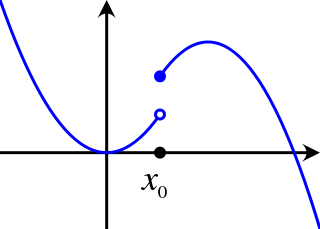Ekeland's variational principle
Preliminary definitions
A function valued in the extended real numbers is said to be bounded below if and it is called proper if it has a non-empty effective domain , which by definition is the set
and it is never equal to In other words, a map is proper if is valued in and not identically The map is proper and bounded below if and only if or equivalently, if and only if
A function is lower semicontinuous at a given if for every real there exists a neighborhood of such that for all A function is called lower semicontinuous if it is lower semicontinuous at every point of which happens if and only if is an open set for every or equivalently, if and only if all of its lower level sets are closed.
Statement of the theorem
Ekeland's variational principle [7] — Let be a complete metric space and let be a proper lower semicontinuous function that is bounded below (so ). Pick such that (or equivalently, ) and fix any real There exists some such that
and for every other than (that is, ),
Define a function by
which is lower semicontinuous because it is the sum of the lower semicontinuous function and the continuous function Given denote the functions with one coordinate fixed at by
and define the set
which is not empty since An element satisfies the conclusion of this theorem if and only if It remains to find such an element.
It may be verified that for every
- is closed (because is lower semicontinuous);
- if then
- if then in particular,
- if then
Let which is a real number because was assumed to be bounded below. Pick such that Having defined and let
and pick such that For any guarantees that and which in turn implies and thus also
So if then and which guarantee
It follows that for all positive integers
which proves that is a Cauchy sequence. Because is a complete metric space, there exists some such that converges to For any since is a closed set that contain the sequence it must also contain this sequence's limit, which is thus and in particular,
The theorem will follow once it is shown that So let and it remains to show Because for all it follows as above that which implies that converges to Because also converges to and limits in metric spaces are unique, Q.E.D.
For example, if and are as in the theorem's statement and if happens to be a global minimum point of then the vector from the theorem's conclusion is
Corollaries
Corollary [8] — Let be a complete metric space, and let be a lower semicontinuous functional on that is bounded below and not identically equal to Fix and a point such that
Then, for every there exists a point such that
and, for all
The principle could be thought of as follows: For any point which nearly realizes the infimum, there exists another point , which is at least as good as , it is close to and the perturbed function, , has unique minimum at . A good compromise is to take in the preceding result. [8]





































































































